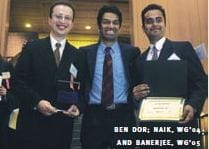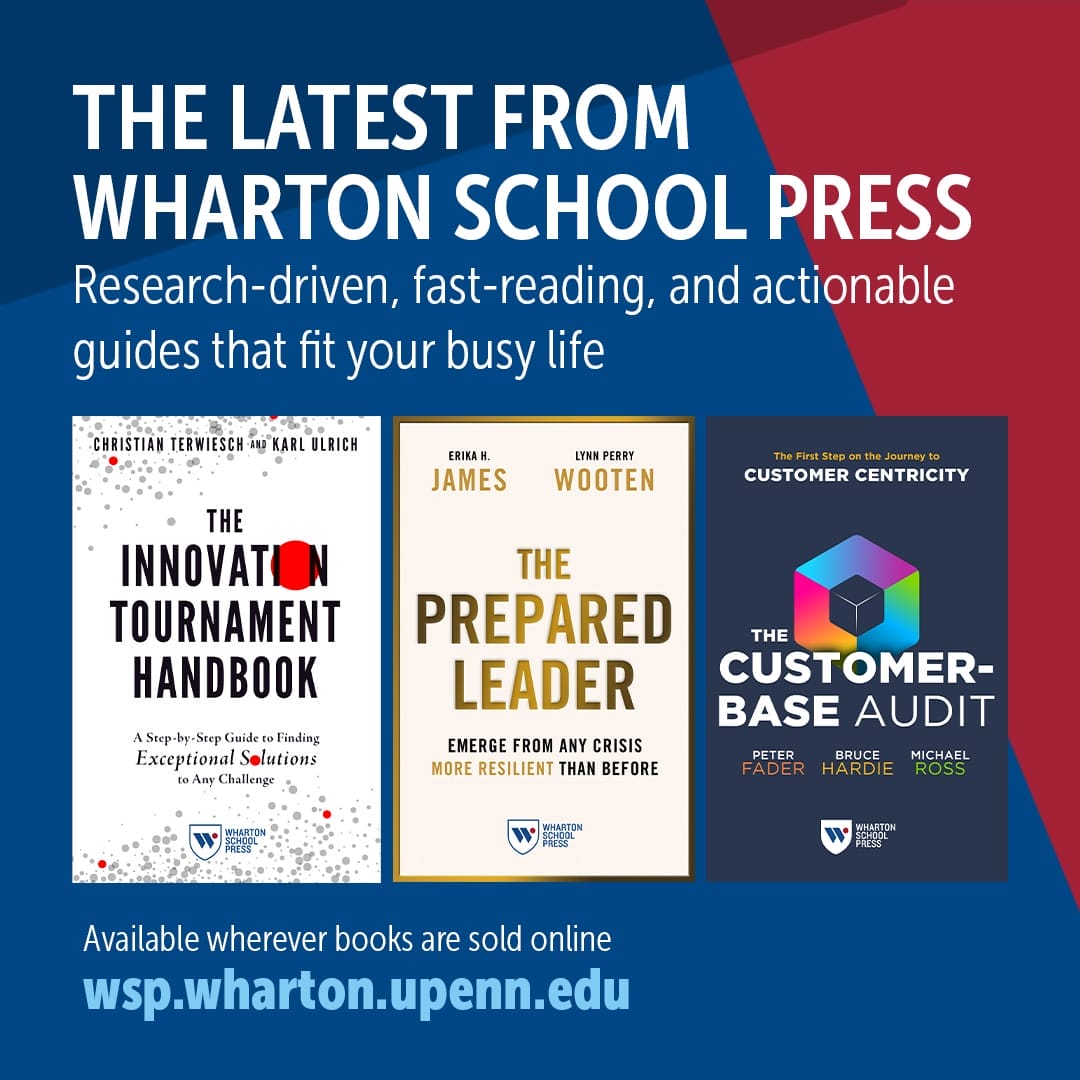Health science trumped the Internet — and everything else — at the 2004 Venture Fair, the culmination of the 2003-2004 Wharton Business Plan Competition. The grand prize went to InfraScan, which has created a device to detect brain bleeding; the second prize went to CelfCure, which would treat neurological ailments with transplanted stem cells; and third place went to BioSpectrum, which aims to improve the way pharmaceutical companies screen for potential drugs. Distributed Resource Imagery, a computer animation company, won the Frederick H. Gloeckner Award as the best Wharton undergraduate team.
As the winners, InfraScan’s team members — two Wharton MBA students and an Israeli physicist — collected $20,000, entry into Wharton’s Venture Initiation Program and a chance to present their business plan at the Global Start-up @ Singapore competition (Co-organized by INSEAD and the National University of Singapore Entrepreneurship Center). CelfCure received $10,000, and BioSpectrum, $5,000. All three teams also will receive $10,000 worth of combined legal and accounting services.
“For the purpose of raising funds, this is extraordinary PR,” said InfraScan founder Baruch Ben Dor, an Israel-trained physicist who moved to Philadelphia in hopes of launching an entrepreneurial venture. “My problem was getting through the first five seconds with a venture capitalist. Winning the Business Plan Competition gives me the first five minutes of his attention.”
“Nearly 200 student teams participated in this year’s competition,” said Emily Cieri, managing director of Wharton Entrepreneurial Programs, which co-manages the event with a student team. “We touched over 700 students across campus, whether they competed or just attended our workshops. We had submissions from 10 of the 12 professional schools across campus.” Any team that includes a University of Pennsylvania student can participate.
InfraScan’s entry was built on its HematoScope. The handheld device would let emergency room physicians and emergency medical technicians do quick scans of people with head trauma to determine the extent of their injuries. About the size of a personal digital assistant, it could help hospitals, especially those in the developing world, more efficiently use scarce CT scanners and MRIs. A patient would be sent for a CT or MRI scan only if the HematoScope detected brain bleeding.
Ben Dor met his teammates — Sandeep Naik, WG’04, and Samonnoi Banerjee, WG’05 — through a posting he placed on a Wharton web site. He sought help with his business plan and investor presentation. Naik responded, suggested they enter the competition, and enlisted Banerjee.
Naik had worked at Medtronic, a Minnesota medical-device maker before coming to Wharton. Thanks to his background, he quickly sensed the HematoScope’s potential.
“I asked Baruch tons of questions. And the more I questioned him, the more I realized that the technology is very simple and low cost. It’s mobile, too. And I found out there’s a huge unmet need.”
Naik, with Banerjee’s assistance, wrote the business plan and delivered the team’s 10-minute presentation at the Venture Fair. After that, the competition’s panel of eight judges — investors, entrepreneurs and a journalist — peppered him and Ben Dor with questions for 10 more minutes.
“This is not just a concept,” Naik said during his talk. “We have a working prototype and have conducted human clinical trials on 305 patients.” He argued that the HematoScope could help reduce health care costs by eliminating unnecessary scans on expensive-to-operate CT and MRI machines.
InfraScan’s scanner grew out of a patent on research by Britton Chance, an emeritus professor of biophysics, biochemistry and radiology at Penn. Chance is something of a legend within his field and at the University. Though 91 years old, he still does research, traveling to his on-campus lab by bicycle. In 1952, he won an Olympic gold medal in sailing as part of a three-man team in the 5.5 meter class.
Ben Dor, a former Israeli Air Force captain, was familiar with Chance’s research and sought him out. Chance decided to hire Ben Dor as chief executive of a dormant company he’d created called NIM, which stands for noninvasive medicine. Chance had started NIM to commercialize the near-infrared technology that undergirds the HematoScope. InfraScan spun out of NIM.
The device “projects light of the proper wavelength into the brain to detect whether there’s bleeding,” Chance explains. “Shed blood absorbs a lot of light, so spilled blood gives a bigger signal than non-spilled blood.”
Second place CelfCure aims to treat neurological ailments, too. It wants to harness what’s called manipulated autologus stem cell therapy, or MAST. In MAST, physicians take cells from a patient’s body, culture them in a lab, load them with drugs, then put them back in the patient. The technology, which has shown promise in research labs, can be used to treat problems such as head and spinal-cord injuries and stroke. So far, it isn’t available for practicing doctors.
The problem, says team member Ajay Bakshi, a neurosurgeon and researcher, is that “biotech companies don’t have access to patients, and hospitals don’t know how to grow cells.” CelfCure would act as a bridge, providing the cultured cells and techniques for transplantation. “Our business proposition rests on developing MAST technologies for various diseases and making them available for medical use by establishing a centralized laboratory,” the team explains in the written summary of its plan.
Third-place BioSpectrum also offers a technology that it believes could help existing health care companies — in its case, drug companies — operate more effectively. It has devised a faster means of screening proteins that have a role in diseases. As with conventional screens, its technology would test the proteins’ responses to large libraries of chemical compounds.
“Understanding proteins enables drug researchers to target more effectively the root causes of disease earlier in the drug-development process, thus saving time and money in a process that currently requires on average 15 years and $800 million,” the team explained in a summary of its plan. BioSpectrum’s technology allows it to miniaturize the chemical reactions required to run screens. That lets it run more screens on the standard-sized plates that drug companies use for the tests and reduce waste. Rather than licensing its technology, BioSpectrum would perform screens for drug companies and contract-research companies.
Rounding out the Great Eight, as the finalists are known, were Greenhands, a retailer of environmentally friendly fuels; IL Aerospace Technologies, a space tourism company; Integrated Biometric Solutions, a developer of biometric entry systems for hotels; and Solestia, a provider of solar-system financing.
An eight-person panel judged the finals of this year’s competition. The panel included representatives of St. Paul Venture Capital, Canaan Partners, JK&B Capital, Johnson & Johnson, Sienna Ventures, Microsoft and Business 2.0 magazine. Entrepreneur John Osher, a former Wharton Entrepreneur-in-Residence, also served as a judge. More than 300 volunteers served as judges for earlier stages of the competition and as mentors for the participants.
WEP’s Cieri said the hefty number of participants, from students to alumni and friends of Wharton, distinguished this year’s competitions from prior ones. “We had a 45 percent increase in the number of judges,” she pointed out.
This year’s competition also scored several firsts. For the first time, a team from Wharton West — IL Aerospace Technologies — and two undergraduate teams — Distributed Resource Imagery and Integrated Biometric Solutions — made it to the finals.
Reprinted from the Get It Started Newsletter, www.wep.wharton.upenn.edu


























